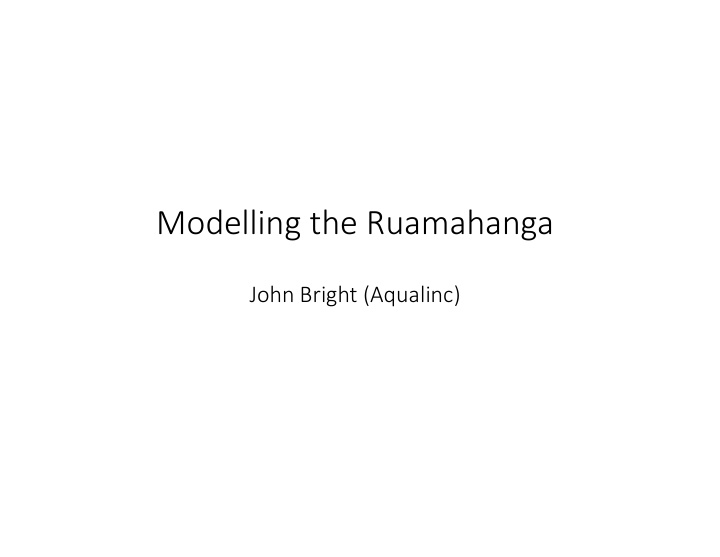



Modelling the Ruamahanga John Bright (Aqualinc)
Outline • Why use models? • Purpose statement • Which models? • How will they be used? • Why model the Status Quo? • Scenarios – what’s their role?
Context: Why use models? • You have set out a number of outcomes for the Ruamahanga catchment • Holistic land and water management • Enhanced recreational opportunities • Sustainable economic future • Etc.
• How will these outcomes be achieved (WIP)? • New/changed policies and rules • New /changed infrastructure • Changing water & land use practices • Etc. • If we did one or more of these, what would be the consequences? • On the main driver? • On “everything” else? • Given the consequences, how do you decide what to go ahead with?
Challenge is there are many connections between the many ‘things’ that characterise a catchment
The shear number of interactions in a catchment system • ‘…. necessitates a reliance on models and modelling’ • ‘Fit for purpose models are essential tools for managing water quality (and quantity) at both catchment and enterprise levels.’ (LaWF)
What are the primary purposes for modelling in this context? • To help you make the judgement calls required to set objectives, standards and limits, by providing them with relevant information. • To demonstrate that an enterprise (or cluster of enterprises) is operating within their share of the limit(s).
Modelling provides information to support judgement calls. Information on how attribute states change in response to changes in resource use helps provide clarity and transparency to the decision making process. (From Snelder et al, 2013)
The primary purpose for modelling in the context of the whaitua process: • To help you make the judgement calls required to set objectives, standards and limits. • Scientists & Modellers are not the decision makers…. Should act as honest brokers. (From Snelder et al, 2013)
Do all values, attributes and connections in a specific water management unit need to be modelled? • Not feasible to do so… • Time frame • Cost • Not necessary to do so… • Use surrogates when necessary • Drop attributes that don’t respond to changes to the limit.
What determines which models to use? • Magnitude of the issues to be addressed • Time and spatial scales required to address the issues • Budget and time available • Availability of data and codified knowledge
Q4 What determines which models to use? Pressure on the Resource Current Capability (actual or expected) Low Medium High Complex, dynamic Availability of Data and Codified High simulation models Most of our water quantity models Hourly, daily series • Catchment or FMU • Simplified, dynamic Knowledge Medium mass-balance Most of our water simulation models quality models Daily, monthly series • Catchment or FMU • Empirical models Low Monthly or annual • statistics Regional •
Interoperability – what is it and why is it important? • No one model will meet all needs. • Requirement for data exchange between models. Some better than others at this! • Open standards help. • The modelling involves a wide range of disciplines. ‘Interoperability’ of the people involved is as important as model interoperability!
Why model the ‘status quo’? • Reproducing, as best we can, the observed and measured past. • Purpose is to build confidence in the modelling and establish a baseline that stakeholders can identify with. • Uncertainty estimates an important part of this • An important by-product of this is being able to explain how and why we have got to where we are in terms of water quality and quantity status. • Gaining agreement on the ‘how and why’ is usually a pre-requisite to being able to agree on how to achieve the mix of outcomes the community seeks.
Scenarios – how are they used? Two distinctly different uses: • Learning how the system functions and responds to climate, stressors etc. • A helpful result from this aspect of scenario testing is ‘myth busting’ – identifying outcomes that are extremely unlikely to eventuate because the system is most unlikely to take you there. • Exploring potential futures to identify the nature of the preferred future, and the types of futures that could arise but the community would like to prevent occurring.
Thank you
Recommend
More recommend